Resisting Bike Culture
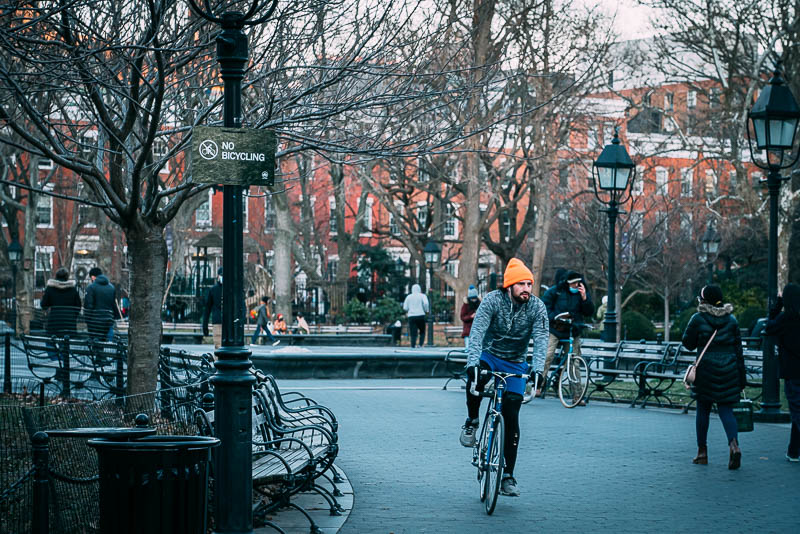
A cyclist in Washington Square Park passing a “No Bicycling” sign.
From the invention of the bicycle a little over two centuries ago, the cyclist has had to fight for the right to the road. Caught between intimidating motorists and unyielding pedestrians, the bike has had to carve its own path as a form of transportation rather than as a form of leisure. This advocacy for the bike, also known as bike activism or “biketivism”, is focused on both promoting bike infrastructure as well as politicizing the bike as a resistance to the domination of automobiles, or “car culture”. The antagonism between cars and bikes starts from the dearth of protected bike lanes on paved roads and extends to the suburban sprawl that renders a bike commute impossible for cyclists who do not qualify for the Tour de France. Yet obsessing over the competition between bicycles and automobiles is ultimately myopic, as bikes are just one of many facets of a livable city.
“Bike culture” is the centering of bicycles not only as a form of transport, but a lifestyle unto itself. Portlandia satirized the obnoxious and selfish behavior associated with “cycling righteousness” in a brief 80-second sketch titled “Spyke’s Bike Lane”. Beyond its “cars are bad” origins, bike culture views pedestrians as obstacles and transit as a weakness. At its core, bike culture is car culture in miniature, simultaneously touting the “freedom” that a vehicle provides while begging municipal governments to build paths reserved solely for cycling. Yet when bringing attention to the injuries and deaths of cyclists, advocates jump at the chance to lump themselves with pedestrians against the evils of motorists. This duplicitous behavior by cyclists is justifiable in their eyes because cycling is such a niche activity that they must form coalitions to get the changes they want. The proliferation of bike advocacy groups, such as MassBike, CalBike, and New York Bicycling Coalition help reinforce the exclusivity of cycling, while organizations that advocate for both walking and cycling focus more on bike lanes than the pedestrian plazas they lead to.
When defining bike culture, it is important to not make the same mistake that detractors of car culture often make, which is to conflate “commuter culture” with “enthusiast culture”. In the Netherlands, cycling country of the world, this distinction is noted by the two different terms for cyclists: “someone on a bike” is known as fietser, while aficionados are wielrenners, or “wheel runners”. Just as most car drivers are commuters that don’t think of themselves as car enthusiasts, most cyclists are “utility cyclists” and don’t think of themselves as hobby cyclists. Just as the sexism, racism, and homophobia of Top Gear do not reflect the beliefs of every driver, the sexism and racism in pro cycling do not reflect the beliefs of every cyclist. But the elitism of hobbyist cyclists does impact how they interact with less experienced cyclists, and since there are so few cyclists, those on-the-road first impressions can change whether or not new cyclists keep cycling. It remains to be seen how e-bike riders integrate with existing bike culture, but it is already clear that riders of electric motorcycles are to be called “bikers”, not cyclists.
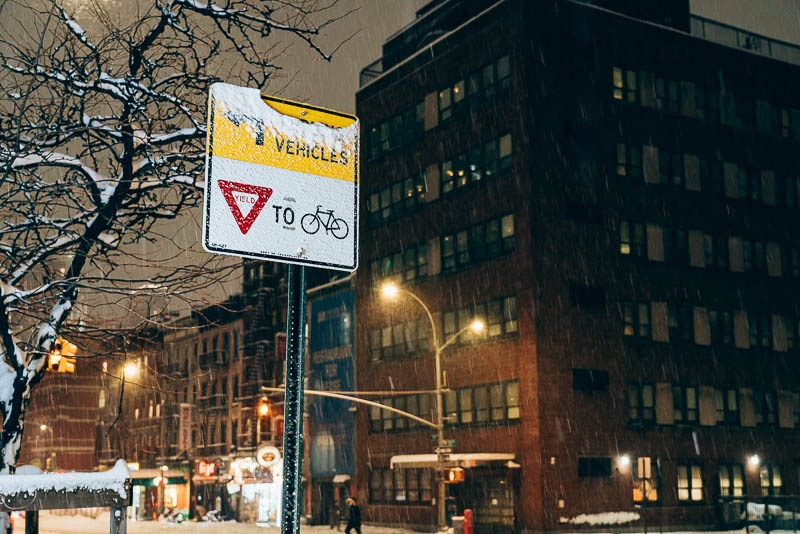
A traffic sign in Manhattan stating that cars must yield to bikes.
Like car culture, bike culture reflects the individualism of owning and operating a vehicle. Historically, the bicycle liberated women from their homes and became “an emblem of women’s rights.” Although bike advocates frame their freedom as being only constrained by physical effort, cyclists are usually still constrained to the same roads and rules as motorists, with the same resulting sprawl that such infrastructure demands, just on a smaller scale. Like the technology of the automobile, cyclists fall for the “myth of liberation-through-consumption,” linking their independence to the time savings of faster transportation while disregarding the increased maintenance labor and related consumerism that bike ownership entails. Cycling advocates have even promoted the aesthetics of cycling via the cycle chic movement. As Josh Bisker in Streetsblog NYC puts it: “many bike activists overlook how gender, race, and capital underpin our relationship to commodities as basic as free time, disposable income, informal mechanical training, agency over where we live and work, and the assumption of fair treatment and personal safety — all crucial passports for entering bike communities and repair spaces.” Human civilization survived millennia without bikes, so despite their mechanical efficiency, bikes have created new avenues for capitalistic exploitation by increasing the distances that workers are expected to travel and a new market for bikes to purchase and maintain. The consumerism of cycling stands in stark contrast with the freedom it supposedly promotes.
Even though cyclists become pedestrians once they dismount their bike, cyclists still fixate on the idea of “cycling as the only legitimate travel mode for all people everywhere.” This blindness to walking and transit mirrors the motorist’s blindness to cyclists and pedestrians and hampers collaboration between different modes of transportation needed to facilitate infrastructure redesigns. This attitude leads to opinion pieces by cyclists that proclaim “ticketing cyclists is pointless and cruel,” as if cyclists running red lights poses no harm to other cyclists or pedestrians even if it’s legal in some places.
In the car-free Central Park loop, cyclists feel free to run red lights and hit pedestrians, to the admonishment of blogger Bike Snob NYC. Even a cyclist – on an e-bike – has died after colliding with a pedestrian in 2019. The obsession with maintaining momentum is so extreme that New York Cycle Club has a protocol for practice rides to keep fast cyclists out of Central Park after 7 am each day. Perhaps the city was right to ban cyclists from Central Park in the late 1860s for disrupting the environment, although a cycling club sued to overturn the ban decades later. Today’s cycling elites have realized that self-regulation is need to keep bike culture from being even more hated by pedestrians.
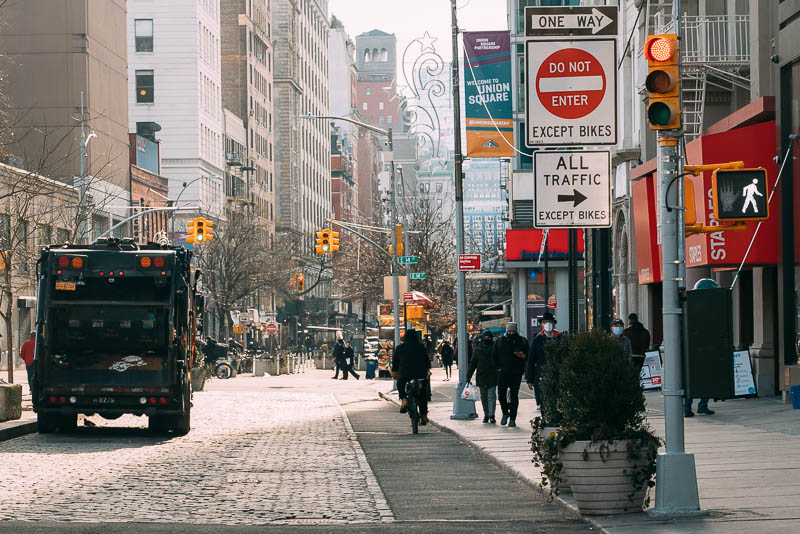
A bike path on the west side of Union Square with a traffic sign allowing bikes to go through.
Although pedestrians and cyclists should be on the same side fighting for space from cars, in Amsterdam, where cyclists dominate, pedestrians have to fight for their share of the road and the street. One writer remarks that “the pecking order in the Netherlands was once aptly summed up by a friend of mine: ‘Cyclists, motorcyclists, cars… and THEN pedestrians.’” Cyclists are not even friendly to each other in times and places of peak congestion, mirroring the road rage experienced by motorists in car-centric cities like Los Angeles. In one particularly narrow cycle superhighway in London, a cyclist overtaking during a congested time can easily cause an accident. Maybe pedestrians have to start aggressively asserting their presence by yelling “Hey, I’m walkin’ here” at road users failing to yield rather than meekly waving flags.
The New York Times reports that on the bike paths in Paris during the coronavirus pandemic, “hospitals have reported an increase in injuries among bike riders and pedestrians hit by them.” There is no accountability for cyclists that hit pedestrians once they leave the scene, even as bike advocates complain when bike-car crash statistics are fudged by the NYPD. Cyclists, like cars, should be pulled over for speeding on a bike, but even that is a slap on the wrist as there are no demerits for moving violations that would take a bike away from a cyclist. Even if a cyclist hits a pedestrian, they are not required to have the liability insurance that motorists are required to have (in most places), so injured pedestrians have to sue to recuperate their medical costs. Cyclists are simply unwilling to own the responsibility of operating a vehicle, even though the rules are vastly looser than those imposed on motorists. If a car accident should be a “car crash” to assign culpability to the driver, a bike accident should be a “bike crash” for the same reasons. It is unfortunate that without licensing – which would be discriminatory to children – cyclists “can’t be banned for poor conduct on the road” and are just subject to rarely-issued fines. Perhaps just as cyclists wear cameras to record incidents with other road users, pedestrians should do the same.

NYPD cyclists on the Brooklyn Bridge.
The hubris of cyclists is most apparent in high throughput spaces, like the Brooklyn Bridge Pedestrian Walkway, which is infamous for being half bike path and half walkway. Even in the cycling mecca of Amsterdam, pedestrians are allowed to cross bike paths at any point, although cyclists are quick to blame pedestrians for “distracted walking”, a spurious claim when walking paths need to accommodate the blind and disabled who have no other choice. Amsterdam has been cracking down on texting while cycling, issuing thousands of fines for cyclists holding their phones. Maybe cities need to hire NBA referees to catch pedestrians traveling with their phones, but critics could argue they are simply artists with phones instead of basketballs.
After considering the sheer number of pedestrians crossing the Brooklyn Bridge, devoting half of the promenade to a bike path is an inefficient use of space. This echoes arguments by bike advocates for wider bike lanes on Manhattan avenues because there is a similar throughput of cars and bikes, even though bikes much less space than a car. Correspondingly, a pedestrian takes up much less space than a bicycle! To solve this problem, the promenade could be expanded, but the expedient choice by Mayor Bill de Blasio in 2021 seems to be to reserve a car lane for cyclists. An even better decision would be to bring back the trolleys that once ran on the roadway. It only takes a quick peek at photos from the Northeast blackout of 2003 to see how many pedestrians can fit on the Brooklyn Bridge roadbed.
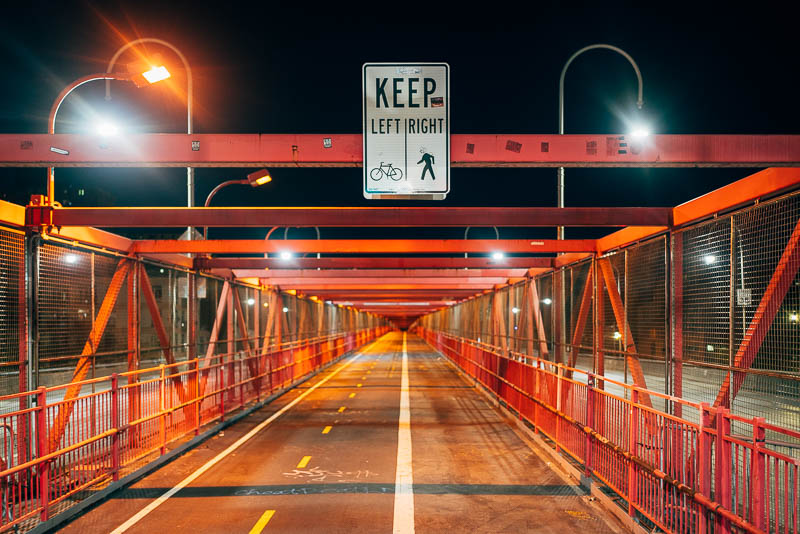
The shared Williamsburg Bridge pedestrian and bike path, with more space allocated to cyclists.
What cyclists really want is identical to drivers: a bicycle-only highway for fast and unimpeded travel. These serve the needs of both commuter and leisure cyclists but exclude pedestrians, who are too slow and reduce the efficiency of cycling. It is ironic that bike paths were first created to keep cyclists from impeding motorists yet are now desired by cyclists. Perhaps in addition to the protected bike lanes cherished by cyclists, they would also enjoy the outdated pedestrian fencing still seen in Hong Kong that aims to protect those walking from moving vehicles, even though removing them has reduced injuries because both motorists and pedestrians are more careful when navigating the street, perhaps because the motorists are driving slower. It is hard to imagine how pedestrian behavior has changed.
Like motorists, cyclists are not willing to pay the tolls that finance other forms of transport, even as transit users are forced to pay for space-efficient public transit. Instead, bike advocates prefer to conflate the idea of pedestrian-only bridges like the Millenium Footbridge in London with pedestrian and bike bridges to garner support for an East River bridge that would mainly be used by cyclists. Pedestrians crossing the river would rather use transit – the NYC DOT estimates that the Williamsburg Bridge, which is not much of a tourist attraction, carries “92,000 transit riders, 600 bikers and 500 pedestrians” daily. The East River Ferry is also a paid alternative to walking across half-mile wide river, albeit less frequent than the subway. Bike advocates need the deep pockets of motorists or the volume of transit riders to pay for bike infrastructure to avoid taking space away from pedestrians.
The free flow capacity of a car lane occupied entirely by cyclists is over 5,000 cyclists an hour at 15 km/h (9 mph) according to urban economist Alain Bertaud’s book, Order Without Design. This theoretical value is much higher than the number of cyclists seen in practice. Even the “busiest cycle path in all of The Netherlands” carries less than 1,500 cyclists an hour. This is still lower than the theoretical maximum capacity of cars, which is approximately 2,000 vehicles per hour. But Bertaud notes that “bicycles provide a much higher road capacity at speeds below 15 km/h than any other mode of transport” with the assumption that cyclists have an entire car lane. This is because a cyclist riding at a leisurely 10 km/h (6.2 mph) takes up 6.4 square meters (69 square feet), accounting for spacing between vehicles, while a car at the same speed takes up four times the amount of space, 24.5 square meters (263 square feet). Combined with the physical difficulty of achieving high speeds, the utility of biking lies not in the long distances it can cover, but in how it enhances last-mile mobility.
Since cycling is so effective, bike congestion is inevitable even on roads shared with cars. For example, London’s Blackfriars Bridge already had a high density of bikes back in 2016, although there are still too few bike lanes in London even a couple years later. In Utrecht, which has a much bigger problem with bike congestion, Youtuber BicycleDutch remarks that “we all know that more asphalt isn’t the answer to too many cars, it is probably also not the best answer to too much cycling.” Echoing that sentiment, Robin Heydon in Cambridgeshire Live states that “building more cycleways will not significantly increase the speed of traffic, but will allow more people to move around the city at peak times.” If car congestion cannot be fixed by speeding up traffic, how can bike congestion be fixed by speeding up bikes?
The problem is that free flow speed (“freespeed”) requires the road to be uncongested. When too many vehicles enter the road, the area needed for uninterrupted flow no longer exists, so vehicles are forced to slow down for their own safety. If public transportation is a viable and frequently-used alternative, like in London and New York, the Downs–Thomson paradox says that car traffic speed is limited by the door-to-door speed of an equivalent trip by public transportation. This is because public transport does not slow down when there are more passengers. Cyclists are not immune to problems of congestion like cars, especially because useful bike lanes are interrupted by intersections to connect to other roads. The congestion, interruptions, and low acceleration of bikes explain why bike lanes do not reach their theoretical free flow capacity.
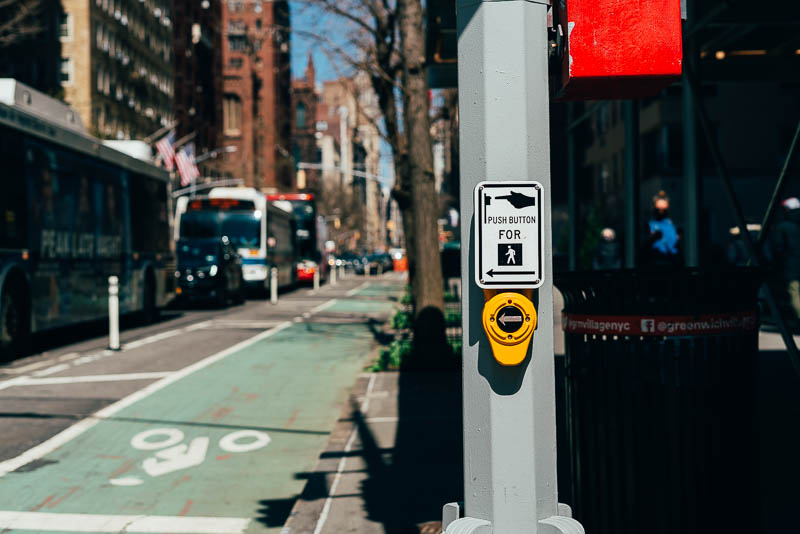
A “beg button” installed on 5th Avenue and 8th Street in Greenwich Village.
A green wave is a strategy to time the stoplights so that cyclists can smoothly travel without having to stop, leading to uninterrupted flow. By prioritizing the cyclist over the motorist, traffic engineers can optimize the throughput of the road, but this scheme still ignores the pedestrian that usually travels much more slowly. In pedestrian-heavy intersections, pedestrian scrambles should be used to stop all traffic and make the intersection safe for those walking. Although in another conflation of pedestrians and cyclists, scrambles in Los Angeles allow cyclists to ride through them without dismounting, which relies on the sensibility of cyclists to not barrel through pedestrians like bowling pins. Presumably, some cyclists are aligned with motorists in the installation of beg buttons that pedestrians have to trigger to cross the street, although CalBike recognizes that loop detectors for cars may not be triggered by bikes. In addition to removing traffic lights, cyclists in bike-friendly Amsterdam would prefer if stop signs did not exist at all so that road users can negotiate amongst themselves. Will cyclists yield to pedestrians with right-of-way? Or will cyclists side with motorists and demand that pedestrians be restricted to pedestrian infrastructure that keeps them off the road?
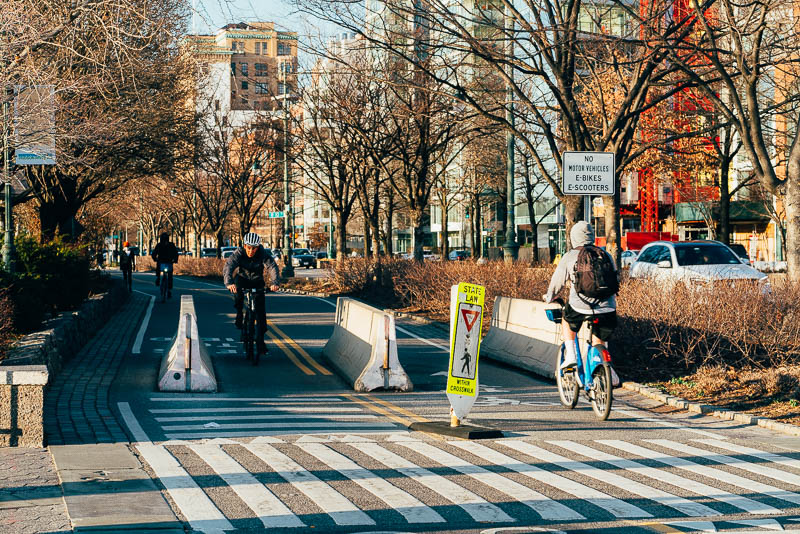
A crosswalk on the Hudson River Greenway. Note that e-bikes are banned.
“Congestion is due to a mismatch between road space supply and demand” according to Bertaud. To increase supply, instead of widening roads the way that Texas widens freeways, bike paths on alternate routes, even if they are less direct, can help avoid congestion. In London, cars are levied a congestion charge that encourages carpooling and off-peak driving to increase not only the speed of cars, but also the total throughput. A similar congestion charge for cyclists can also work to reduce demand. Using the road space estimates at free flow speed earlier, a £15 congestion charge for cars translates to a £3.75 charge for bikes. Note that Transport for London also charges the same price for motorcycles, which suggests a fee closer to £7 for bikes. In either case, the charge is higher than the cost of traveling on the Tube within zone one, £2.40, or the cost of a bicycle hire, £2. Even disregarding the cost of maintaining roads, not charging for bike congestion is a subsidy to cyclists. By charging for increased travel time imposed on other cyclists caused by an additional cyclist, urban planners can ensure road space and public transport resources are allocated efficiently.
Bike congestion is not only a phenomenon when moving, bike parking is also a critical component of cycling infrastructure. Like cars, bikes take up space, often in valuable areas near transit that could go toward public seating or pedestrian use. Although “park and ride” initiatives are promoted with the idea of reducing driving, it is still a subsidy to motorists that encourages car use, sometimes at the expense of bikes. The same logic is applicable to bikes. That is not to say that park and ride for bikes is a poor idea, because carrying bikes onto public transit is an even worse use of space during rush hour. One last mile solution is bike share, which trades the valuable space on a peak train for the cheaper off-peak space needed for parking. Yet transit stations are naturally pedestrian hubs that could serve as valuable real estate to fund the transit system itself, as the MTR does in Hong Kong. Perhaps charging for bike parking, like in Tokyo’s Kasai Station, is a good solution that accounts for the value of the space that could have gone to other uses. Transit-oriented development prioritizes high-density uses of land near transit stations that prioritize walkability.

E-bikes and cargo trailers stored in a garage near Union Square.
Cycling not only occupies the narrow strip of road between cars and the sidewalk, it also occupies the niche of densities between car-oriented suburbs and walkable city centers. Alain Bertaud asserts that “the low speed of the bicycle, however, prevents it from becoming a significant mode of commuting in cities of more than 1 million people.” Cities hailed as bike-first, such as Amsterdam and Copenhagen, have populations of less than a million, although they also have robust metro systems and access to regional rail. Yet for exceptionally large cities, “advocates of compact cities often ignore the fact that the compact part of their city is already extremely congested and that governments are unable to provide the public transport line intensity that would prevent congestion”. On the other hand, the smaller cities are also crisscrossed with canals that increase the distance between destinations. The spawl extends beyond the city centers too, evident in the number of bike-only bridges that are needed to cross the highways needed to transport freight in Europe.
Bertaud’s proposed solution is to prioritize motorized micromobility, such as motorcycles and tiny cars, to complement transit systems. This strategy extends the catchment area of public transit from 800 meters to 8 kilometers. For cyclists committed to pedal power, this may be easily achievable, but in practice, the average distance cycled in the Netherlands is 3.6 km per trip. Despite the struggles with cycling in high densities, Paris, which has a density greater than that of New York City, is also striving to be bike first. Mayor Anne Hidalgo is aiming to leverage and enhance agglomeration effects via the 15-minute neighborhood initiative. This policy is focused more on walkability, not bikeability, but the bike furthers the reach of the pedestrian without the infrastructure costs of public transit. Yet this emphasis on reducing car dependency is not predicated on road diets, but on the actual destinations of residents, such as schools, restaurants, and grocery stores. “The 15-minute city calls for a return to a more local and somewhat slower way of life, where commuting time is instead invested in richer relationships with what’s nearby” according to a CityLab article from Bloomberg.
The challenge for urban planners is in designing a road network that achieves the medium speeds needed to keep cycling useful and high throughput, without veering into the high speeds that endanger pedestrians and reduce quality of life. Roz Hansen, an urbanist who worked on Melbourne’s city plan, reinforced the interdependency of cycling and public transit, stating that “the 20-minute neighborhood is about active modes of transport and increasing an area’s catchment of accessibility. If you’re walking, 1 to 2 kilometers [1.2 miles] is your catchment. If you’re cycling, it could be up to 5 to 7 kilometers. With public transport, it can be 10 to 15 kilometers.” Hansen’s estimates match up closely with Bertaud’s. The Dutch designed Houten around this concept so that “no one lives more than a mile and a quarter from a train, and a majority of Houten residents live within a mile of a grocery store. That makes it easy to do most of life’s daily chores without a car. The biggest transportation problems that locals face are bike parking, speeding mopeds, and ‘uncollected dog poop.’”
Micromobility makes public transport work better by allowing stops to be spaced further apart, while the high speeds of public transport broaden the area available to those using micromobility. As urban planning consultant Jarett Walker puts it, “the key idea is that we have only so much time. There is a limit to how long we can spend doing anything, and that limit defines a wall.” Bertaud uses a limit of one hour in his analysis, but whatever cutoff is used, the relationships between distance, time, and congestion are critical to understanding urban mobility.
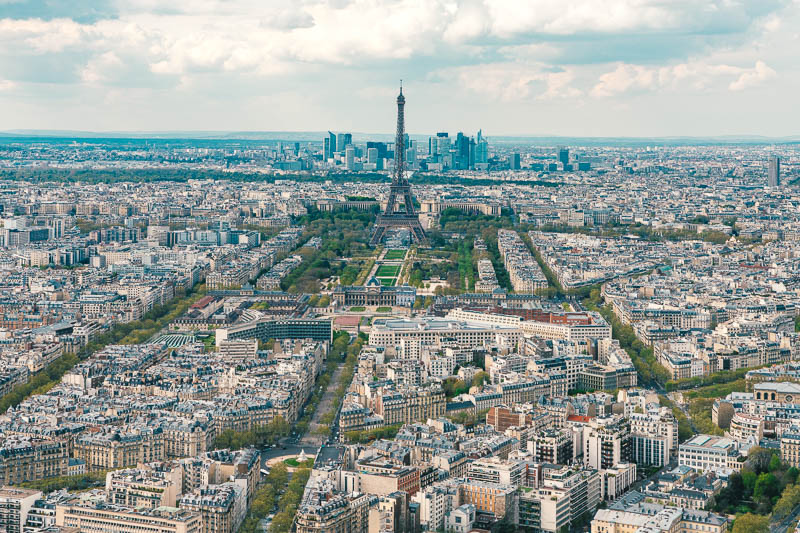
Paris, with the Eiffel Tower in the middle and La Défense in the background.
Although Amsterdam’s density is already considered urban, for the city to grow, it will have to increase density by building up. To preserve the charm of the historic city center, the high density business district is in a different location: Zuidas in Amsterdam, La Défense in Paris, and Ørestad in Copenhagen, although Ørestad is currently a failure. The primary mode of transportation to these business districts is by public transit. But Alon Levy of Pedestrian Observations notes that the important thing to understand is that [transit-oriented development] sites are practically never going to eclipse the [central business district].” At the same time, “the economic growth of Paris has been possible, in spite of the freezing of the built envelope of historical Paris, due to the rapid growth of suburban Paris”, according to Bertaud.
Bikeability in Amsterdam and Paris are an accidental necessity due to their prioritization of urban form in their central business districts. For other cities, the bike also occupies a narrow moment in time in a city’s evolution from low to high density due to economies of agglomeration. Cities with even denser central business districts (CBD), such as New York, will also begin to sprawl as they reach the limits of public transit, but it would be wrong to blindly copy the bike infrastructure of cities that have their own motivations for promoting cycling. Philosopher André Gorz warned in 1973 that “above all, never make transportation an issue by itself. Always connect it to the problem of the city, of the social division of labour, and to the way this compartmentalizes the many dimensions of life.” Bike culture echoes car culture in its obsession with a particular mode of transportation rather than the greater goal of mobility.
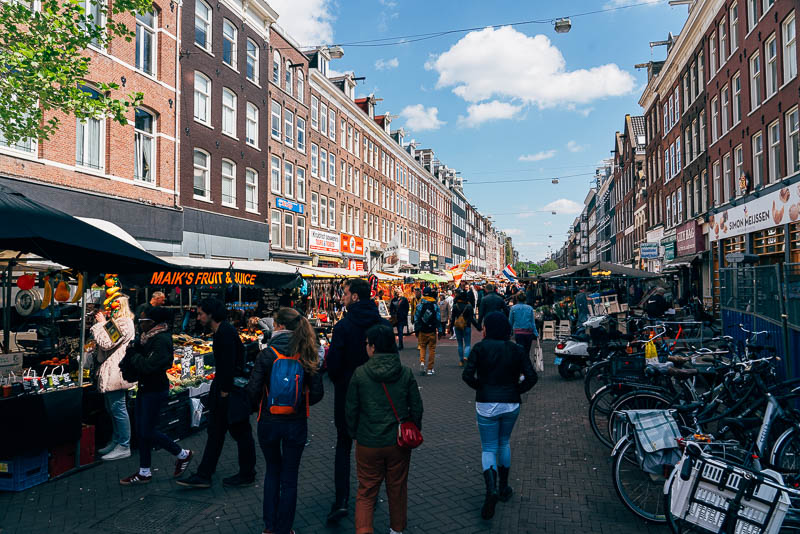
A pedestrian area in Amsterdam, 2018.
“Pedestrianism is the grease [that] makes alternative transportation work,” according to a Reddit comment. A vision for urban mobility should also aim to turn origins and destinations into worthwhile places to be. As the title of an article in Cambridgeshire Live puts it, “if transport networks are solely planned for cyclists and motorists ‘we lose something’”. To combat the focus on transportation, the one-minute city focuses on creating third places for hyperlocal communities. Rather than only turning car parking into denser bike parking, parklets and outdoor dining structures turn valuable outdoor streets into community spaces that promote the slow living the leaders of Paris desire. They echo the “nooks and crannies” of walkable vacation spots, such as Venice and Mykonos that keep a place interesting rather than a place to pass by on a bike or car. Similarly, the high streets of London are often overlooked in how they bring amenities closer to the homes of Londoners.
New York needs to move beyond creating more miles of bike lanes to pedestrianizing more streets. This will be a shift from the temporary nature of “Summer Streets” to a more permanent model of “Open Streets.” In these spaces, cyclists no longer need to be protected from cars, but pedestrians will need to be protected from cyclists. Levy argues that most of Lower Manhattan should be pedestrianized, although from their perspective, reducing the number of car lanes also counts. The current difficulty in procuring funding suggests the sorry state of pedestrian advocacy in New York, though there are plenty of bike advocacy organizations clamoring for more bike lanes.

University Place, a shared street south of Union Square with ample bike parking.
A recent op-ed in Streetsblog NYC puts it this way: “every part of the city deserves genuine people-first street space, and there are streets like University Place in every borough: relatively low-traffic, short, non-connecting roadways with intensive human traffic that are adjacent to transit, with parallel vehicular alternative routes that can easily absorb rerouted cars and trucks.” Reinforcing this idea, in the adjoining street, the Union Square Partnership found in the recently released Union Square-14th Street District Vision Plan that “based on the traffic data analysis, there is a great need for additional pedestrian space on 14th Street between University Place and 4th Avenue.” The future of mobility and livability in New York can no longer fail to account for the needs of pedestrians that make New York a place worth living in.
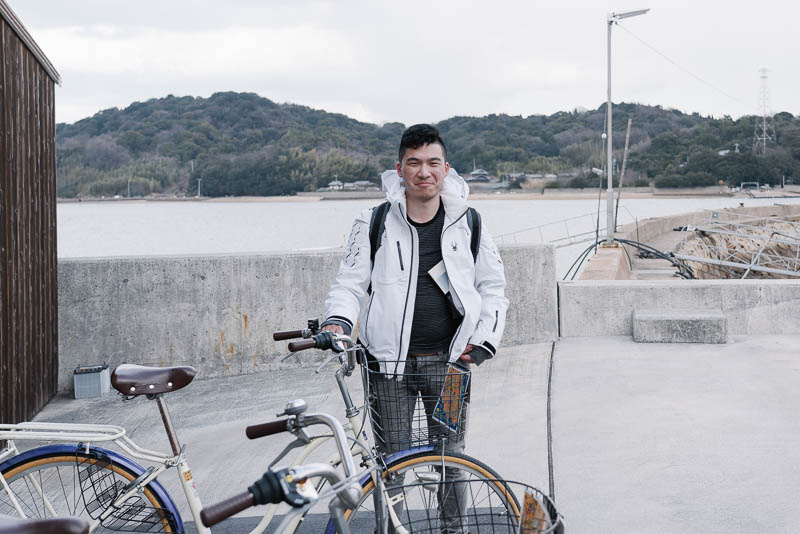
The author posing with a bike rented for transportation on the island of Naoshima in Japan.